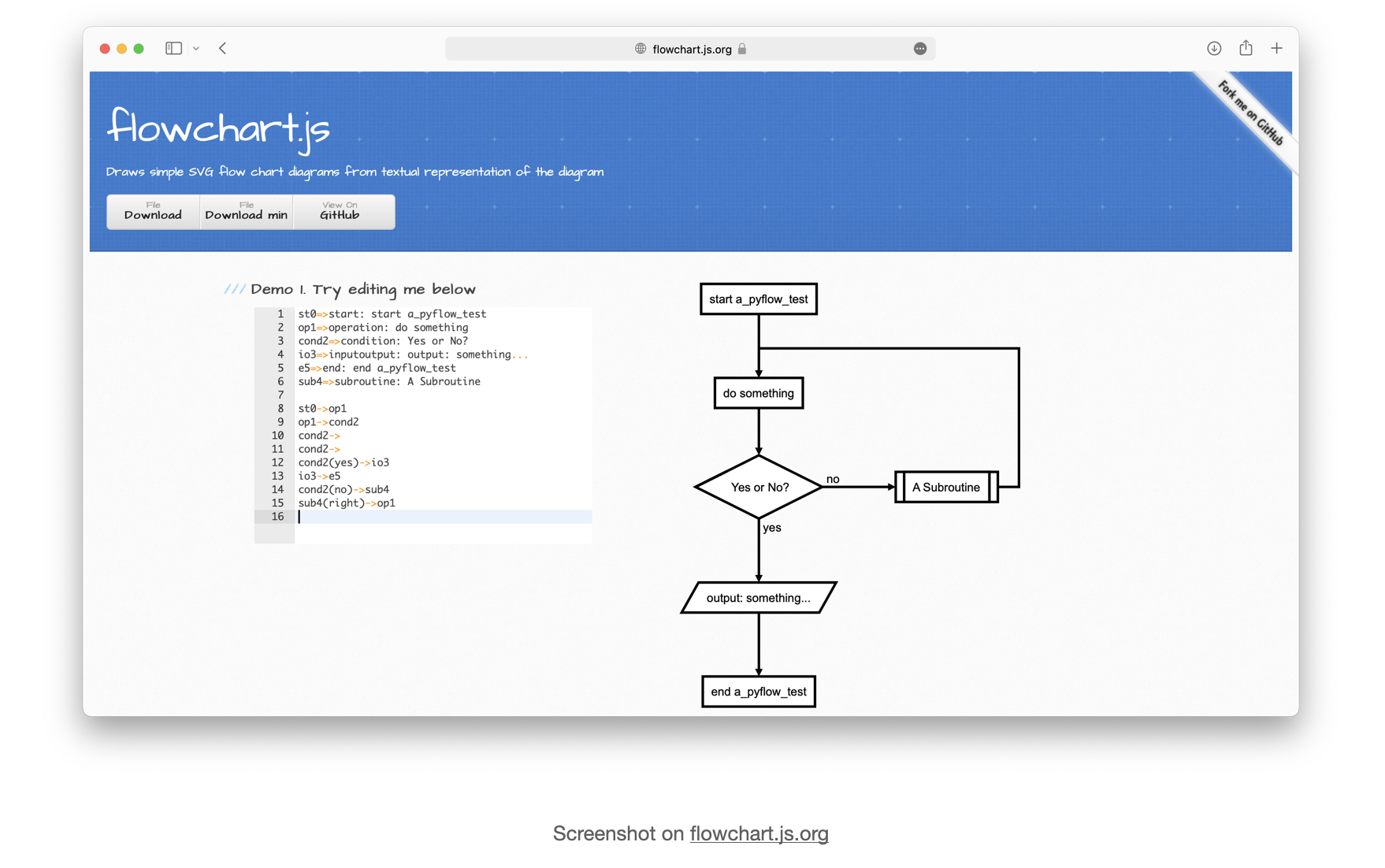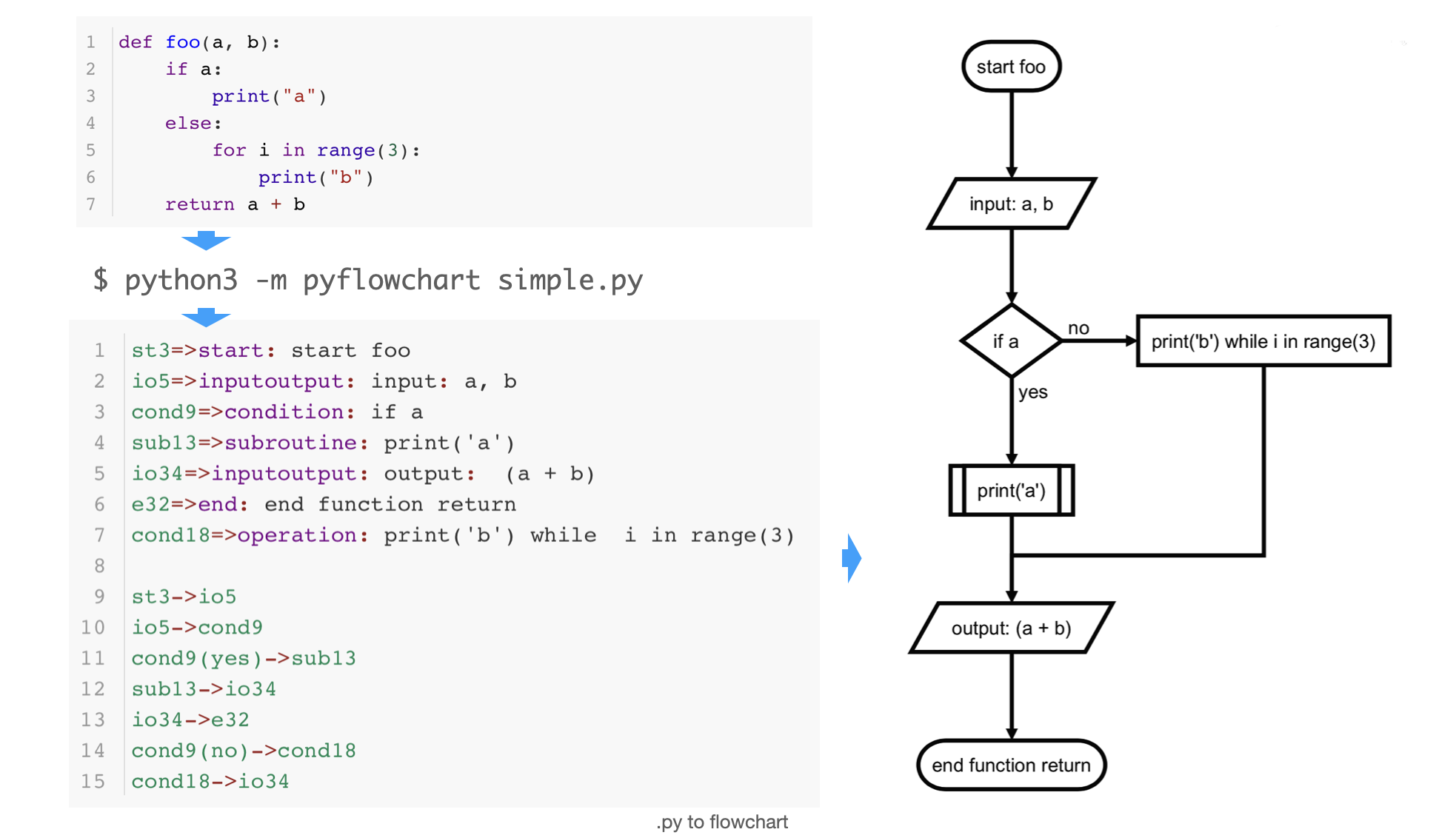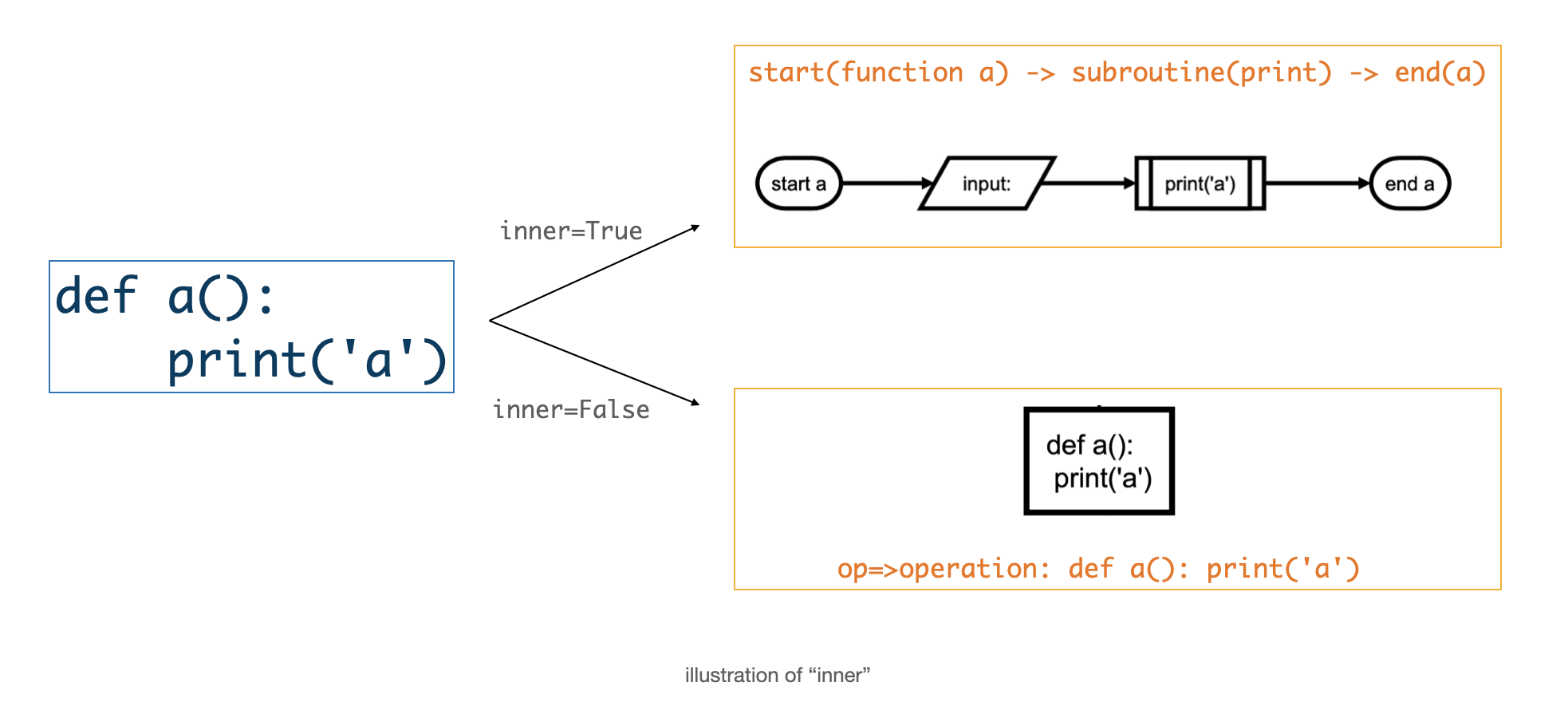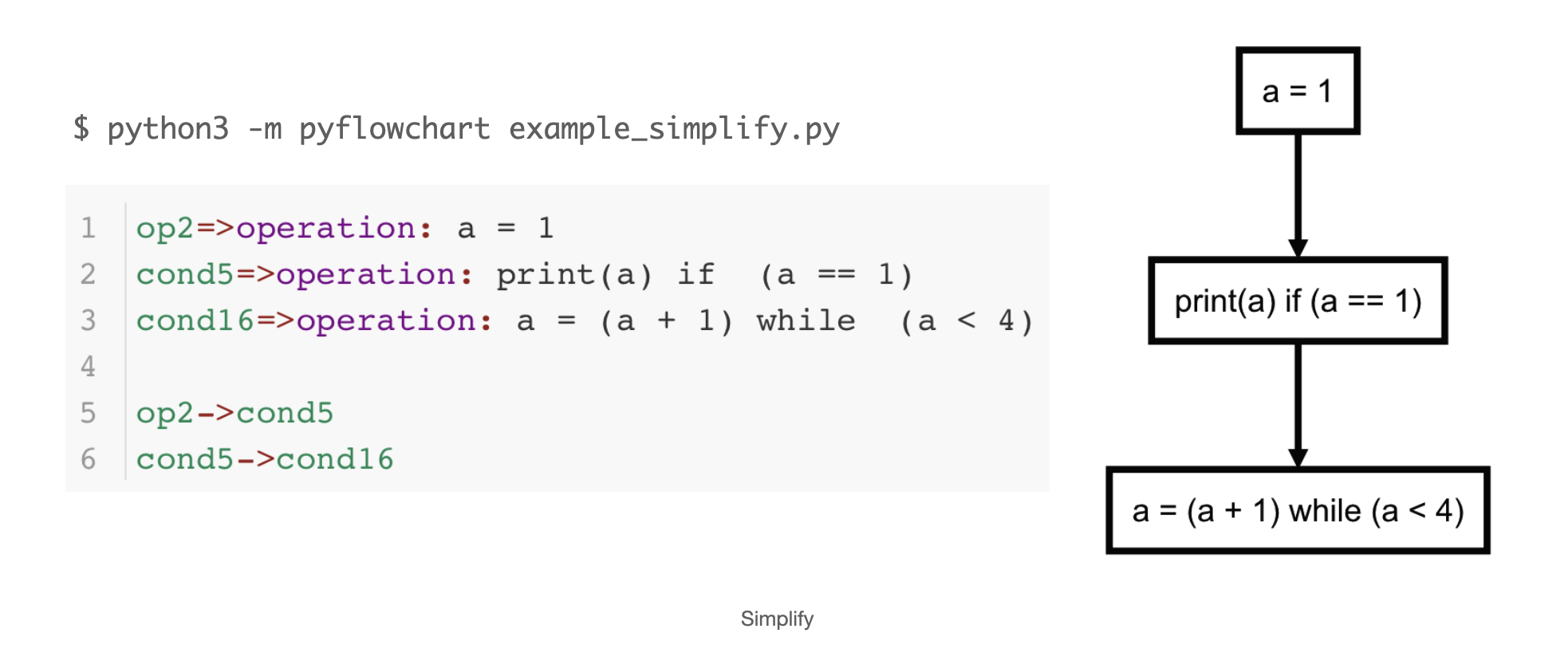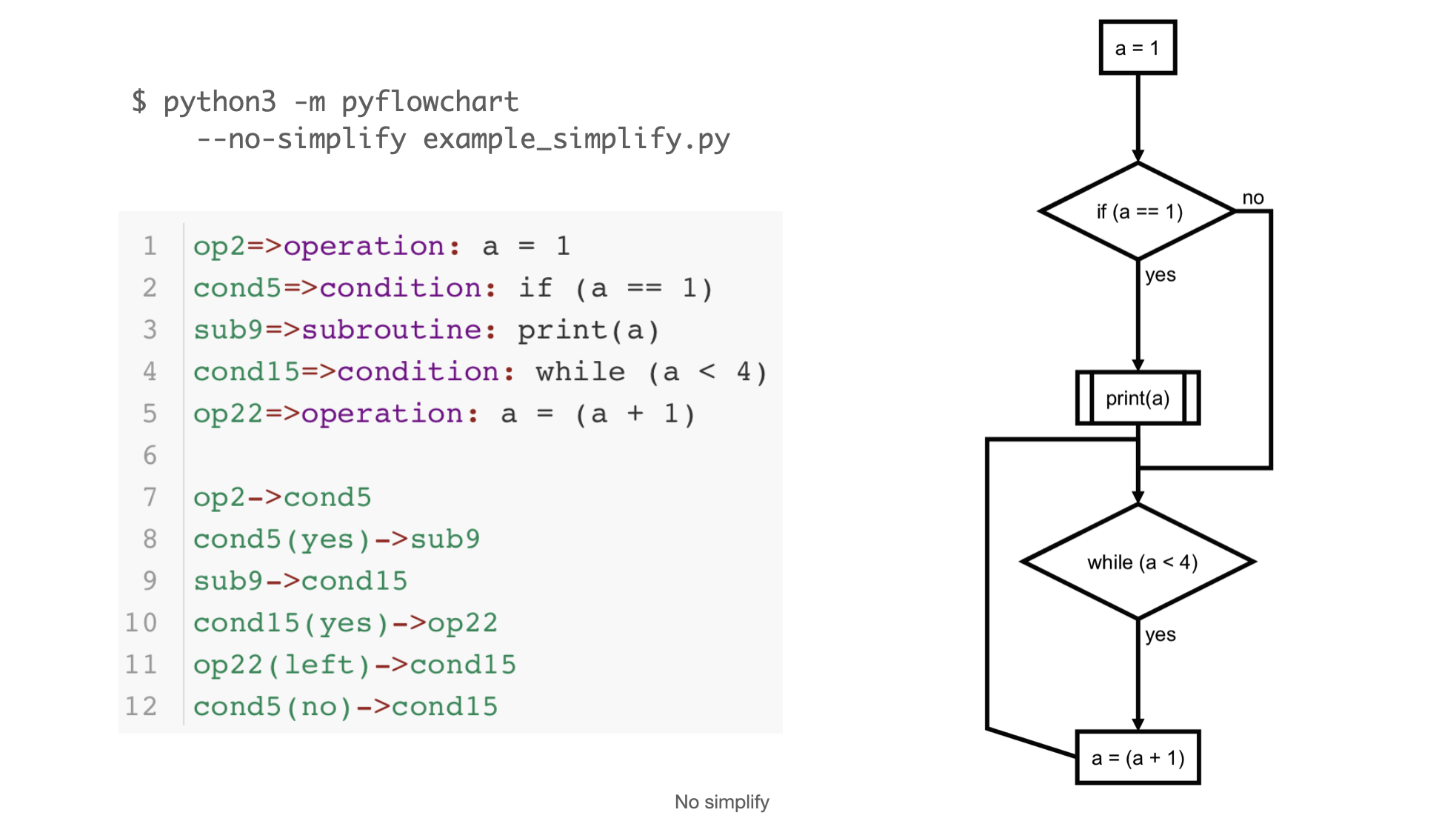PyFlowchart
English | 机翻中文
PyFlowchart is a package to:
- write flowcharts in the Python language,
- translate Python source codes into flowcharts.
PyFlowchart produces flowcharts in flowchart.js flowchart DSL, a widely used flow chart textual representation. It's easy to convert these flowcharts text into a picture via flowchart.js.org, francoislaberge/diagrams, or some markdown editors.
Get PyFlowchart
$ pip install pyflowchartQuick Start
To flowchartlize your python codes in example.py,run:
$ python -m pyflowchart example.py
⚠️ PyFlowchart works with Python 3.7+. To check your python version, please runpython --version. If there are both Python 2 and Python 3 installed, it could require you to usepython3instead ofpython, though this is becoming rare due to the sunset of Python 2.
PyFlowchart will output the generated flowchart.js DSL. Go to http://flowchart.js.org or use editors like Typora to turn the output code into a rendered diagram.
To specify a function (or a method in a class) to flowchartlize:
$ python -m pyflowchart example.py -f function_name
# or
$ python -m pyflowchart example.py -f ClassName.method_name🎉 Now you are ready to enjoy the flowchartlization.
Keep reading this document to learn more usages.
Flowchart in Python
PyFlowchart allows you to write a flowchart in Python which could be translated into the flowchart.js DSL automatically.
PyFlowchart supports flowchart.js node types:
- StartNode
- OperationNode
- ConditionNode
- InputOutputNode
- SubroutineNode
- EndNode
Nodes can be connected by connect() method (connect_{yes|no} for ConditionNode). An optional second parameter to connect() is used to specify the connect_direction.
Get a Flowchart with your start node and call its flowchart() method to generate flowchart.js flowchart DSL:
from pyflowchart import *
st = StartNode('a_pyflow_test')
op = OperationNode('do something')
cond = ConditionNode('Yes or No?')
io = InputOutputNode(InputOutputNode.OUTPUT, 'something...')
sub = SubroutineNode('A Subroutine')
e = EndNode('a_pyflow_test')
st.connect(op)
op.connect(cond)
cond.connect_yes(io)
cond.connect_no(sub)
sub.connect(op, "right") # sub->op line starts from the right of sub
io.connect(e)
fc = Flowchart(st)
print(fc.flowchart())Output:
st0=>start: start a_pyflow_test
op1=>operation: do something
cond2=>condition: Yes or No?
io3=>inputoutput: output: something...
e5=>end: end a_pyflow_test
sub4=>subroutine: A Subroutine
st0->op1
op1->cond2
cond2->
cond2->
cond2(yes)->io3
io3->e5
cond2(no)->sub4
sub4(right)->op1
Then you can visit http://flowchart.js.org and translate the generated textual representation into SVG flow chart diagrams:
P.S. Many Markdown editors (for example, Typora) support this flowchart syntax, too (reference: Typora doc about flowchart). And if you prefer CLI, see francoislaberge/diagrams.
Set Params to Nodes
Since v0.2.0, we support a Node.set_param(key, value) method to generate flowchart like this:
element(param1=value1,param2=value2)=>start: Start
(See also adrai/flowchart.js#node-specific-specifiers-by-type)
And for convenience, there are grammar sugars to set param align-next=no for ConditionNodes:
cond = ConditionNode("a cond node")
cond.no_align_next()
# or do this at __init__:
cond = ConditionNode("a cond node", align_next=False)This usually works with a connect_direction customization:
cond.connect_yes(op, "right")The generated flowchart will look like:
cond(align-next=no)=>condition: Yes or No?
...
cond(yes,right)->op
Python to Flowchart
PyFlowchart can also translate your Python Codes into Flowcharts.
For example, you got a simple.py:
def foo(a, b):
if a:
print("a")
else:
for i in range(3):
print("b")
return a + bRun PyFlowchart in CLI to generate flowchart code:
$ python -m pyflowchart simple.py
# output flowchart code.Or, in Python
>>> from pyflowchart import Flowchart
>>> with open('simple.py') as f:
... code = f.read()
...
>>> fc = Flowchart.from_code(code)
>>> print(fc.flowchart())
# output flowchart code.Advanced Usages
As mentioned above, we use Flowchart.from_code to translate Python codes into Flowcharts. The from_code is defined as:
Flowchart.from_code(code, field="", inner=True, simplify=True, conds_align=False)PyFlowchart CLI is a 1:1 interface for this function:
python -m pyflowchart [-f FIELD] [-i] [--no-simplify] [--conds-align] code_fileLet's talk about those three args:
field: str: Specify a field of code to generate a flowchartinner: bool:Trueto parse the body of field; whereasFalseto parse the body as a single object.simplify: bool: for If & Loop statements: simplify the one-line-body or notconds_align: bool: improve the flowchart of consecutive If statements converted from python code. (Beta)
field
the field is the path to a field (i.e. a function) you want to draw a flowchart.
# example.py
print("start")
def foo():
foo = "foo"
class Bar():
def buzz(self, f):
def g(self):
print("g")
f(self)
return g(self)
Bar().buzz(foo)
print("end")For example.py above, available paths are:
- "" (means the whole code)
- "foo"
- "Bar.buzz"
- "Bar.buzz.g"
To generate a flowchart of Bar.buzz.g:
# Python
from pyflowchart import Flowchart
with open('example.py') as f:
code = f.read()
fc = Flowchart.from_code(code, field='Bar.buzz.g', inner=False)
print(fc.flowchart())Or:
# CLI
python -m pyflowchart example.py -f Bar.buzz.gOutput result:
inner
inner controls parser's behaving. Techly, inner=True means parsing field.body, while inner=False parses [field]. So, if inner=True, pyflowchart will look into the field, otherwise, it takes the field as a node.
For CLI, adding an argument -i means inner=True, else inner=False.
simplify
simplify is for If & Loop statements: simplify the one-line-body.
For example:
# example_simplify.py
a = 1
if a == 1:
print(a)
while a < 4:
a = a + 1- Default:
simplify=True:
flowchart = Flowchart.from_code(example_simplify_py, field="", inner=True)
print(flowchart.flowchart())
# SH $ python -m pyflowchart example_simplify.py simplify=False:
flowchart = Flowchart.from_code(example_simplify_py, field="", inner=True, simplify=False)
print(flowchart.flowchart())
# SH $ python -m pyflowchart --no-simplify example_simplify.py conds-align (Beta)
Improve the flowchart of consecutive If statements converted from python code with the new feature of v0.2.0.
# example-conds-align.py
if cond1:
op1
if cond2:
op2
if cond3:
op3
op_endBeautify Flowcharts
Sometimes, the generated flowchart is awful. In those cases, you are encouraged to modify the generated flowchart code by yourself OR consider making your python source code at bottom more clear if it's exceedingly complex.
TODOs
- Directly generate flowchart SVG/HTML:
$ pyflowchart example.py -o flowchart.svgDepends on node.js and flowchart.js.
- PyFlowchart GUI
Well, I guess a GUI for PyFlowchart may be remarkable. Pasting your code into it, the flowchart DSL will be generated just in time, and the flowchart will be shown aside.
-
The Chinese README your buddies waiting for!希望有同学帮助贡献个中文 README 呀。 - Tests automation.
Sadly, I am too busy (pronounced as [ˈlеizi]——lazy) to code these ideas. Please submit an issue to push me on. Or, PR to make it by yourself. I cannot wait to appreciate your great contribution!
References
- Inspired by Vatsha/code_to_flowchart
- Based on adrai/flowchart.js, python ast, simonpercivall/astunparse
- A blog about this project
License
Copyright 2020-2022 CDFMLR. All rights reserved.
Licensed under the MIT License.
